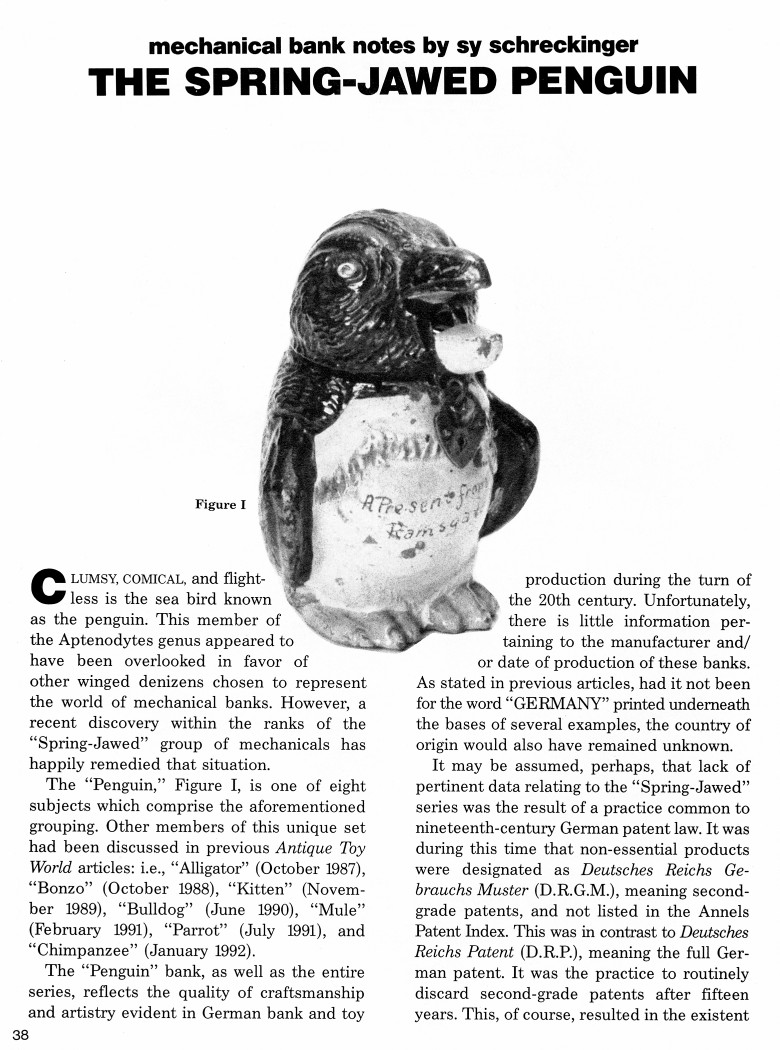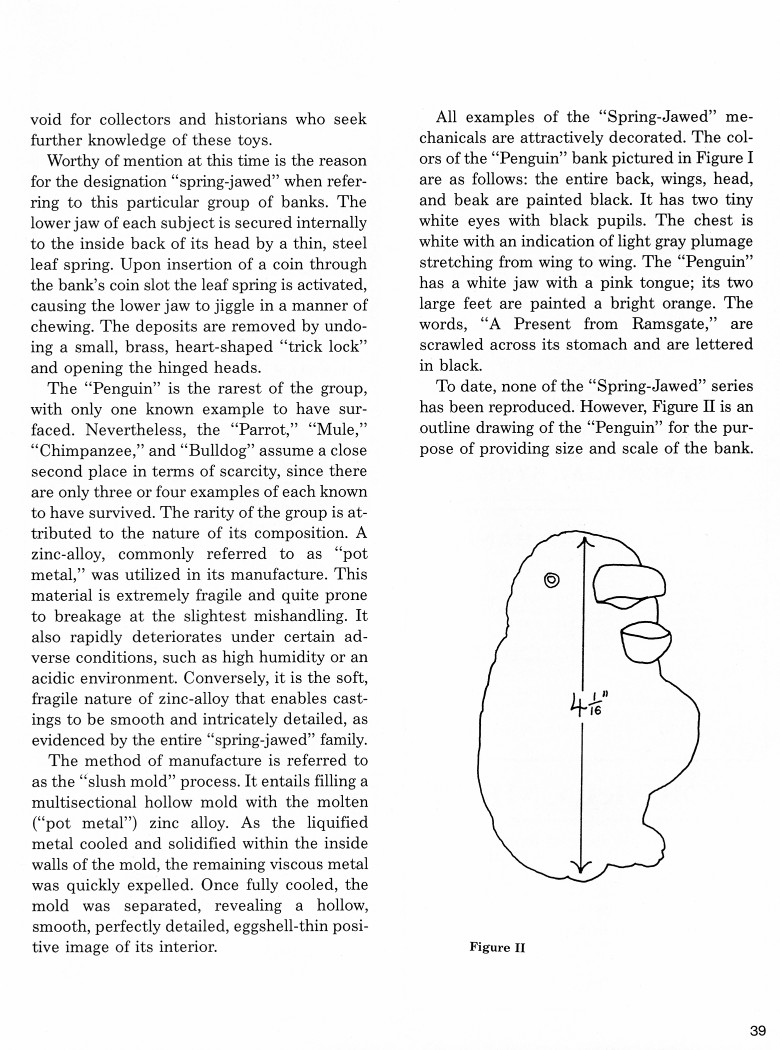|
The Spring-Jawed Penguin
by Sy Schreckinger – ANTIQUE TOY WORLD Magazine – August, 1992
Clumsy, comical, and flightless is the sea
bird known as the penguin. This member of the Aptenodytes genus appeared
to have been overlooked in favor of other winged denizens chosen to
represent the world of mechanical banks. However, a recent discovery
within the ranks of the "Spring-Jawed" group of mechanicals has happily
remedied that situation.
The "Penguin," Figure I, is one of eight subjects which comprise the
aforementioned grouping. Other members of this unique set had been
discussed in previous Antique Toy World articles: i.e., "Alligator"
(October 1987), "Bonzo" (October 1988), "Kitten" (November 1989),
"Bulldog" (June 1990), "Mule" (February 1991), "Parrot" (July 1991), and
"Chimpanzee" (January 1992).
The "Penguin" bank, as well as the entire series, reflects the
quality of craftsmanship and artistry evident in German bank and toy
production during the turn of the 20th century. Unfortunately, there is
little information pertaining to the manufacturer and/or date of
production of these banks. As stated in previous articles, had it not been
for the word "GERMANY" printed underneath the bases of several examples,
the country of origin would also have remained unknown.
It may be assumed, perhaps, that lack of pertinent data relating to
the "Spring-Jawed" series was the result of a practice common to
nineteenth-century German patent law. It was during this time that
nonessential products were designated as Deutsches Reichs Gebrauchs
Muster (D.R.G.M.), meaning second-grade patents, and not listed in the
Annels Patent Index. This was in contrast to Deutsches Reichs Patent (D.R.P.),
meaning the full German patent. It was the practice to routinely discard
second-grade patents after fifteen years. This, of course, resulted in the
existent void for collectors and historians who seek further knowledge of
these toys.
Worthy of mention at this time is the reason for the designation
"spring-jawed" when referring to this particular group of banks. The lower
jaw of each subject is secured internally to the inside back of its head
by a thin, steel leaf spring. Upon insertion of a coin through the bank's
coin slot the leaf spring is activated, causing the lower jaw to jiggle in
a manner of chewing. The deposits are removed by undoing a small, brass,
heart-shaped "trick lock" and opening the hinged heads.
The "Penguin" is the rarest of the group, with only one known example
to have surfaced. Nevertheless, the "Parrot," "Mule," "Chimpanzee," and
"Bulldog" assume a close second place in terms of scarcity, since there
are only three or four examples of each known to have survived. The rarity
of the group is attributed to the nature of its composition. A
zinc-alloy, commonly referred to as "pot metal," was utilized in its
manufacture. This material is extremely fragile and quite prone to
breakage at the slightest mishandling. It also rapidly deteriorates under
certain adverse conditions, such as high humidity or an acidic
environment. Conversely, it is the soft, fragile nature of zinc-alloy that
enables castings to be smooth and intricately detailed, as evidenced by
the entire "spring-jawed" family.
The method of manufacture is referred to as the "slush mold" process.
It entails filling a multisectional hollow mold with the molten ("pot
metal") zinc alloy. As the liquefied metal cooled and solidified within
the inside walls of the mold, the remaining viscous metal was quickly
expelled. Once fully cooled, the mold was separated, revealing a hollow,
smooth, perfectly detailed, eggshell-thin positive image of its interior.
All examples of the "Spring-Jawed" mechanicals are attractively
decorated. The colors of the "Penguin" bank pictured in Figure I are as
follows: the entire back, wings, head, and beak are painted black. It has
two tiny white eyes with black pupils. The chest is white with an
indication of light gray plumage stretching from wing to wing. The
"Penguin" has a white jaw with a pink tongue; its two large feet are
painted a bright orange. The words, "A Present from Ramsgate," are
scrawled across its stomach and are lettered in black.
To date, none of the "Spring-Jawed" series has been reproduced.
However, Figure II is an outline drawing of the "Penguin" for the purpose
of providing size and scale of the bank.
|


